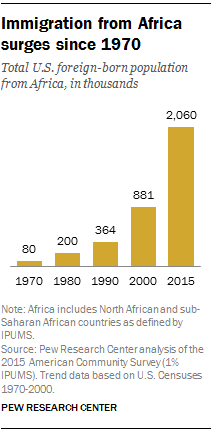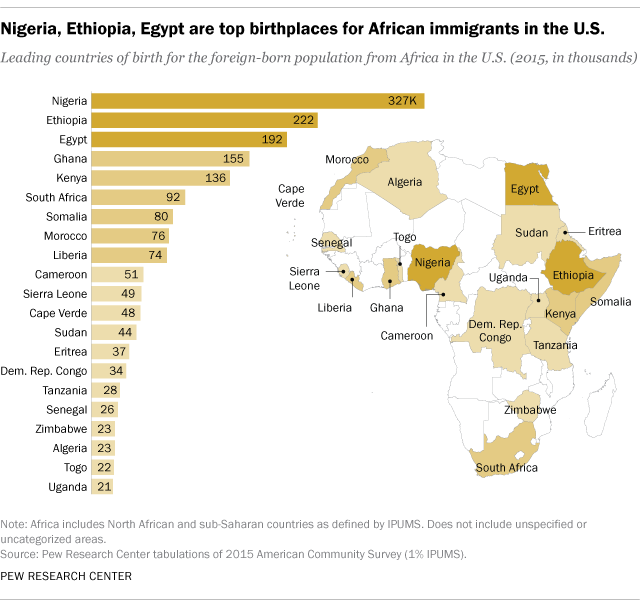
African immigrants make up a small share of the nation’s immigrant population, but their overall numbers are growing – roughly doubling every decade since 1970, according to a new Pew Research Center analysis of U.S. Census Bureau data.
There were 2.1 million African immigrants living in the United States in 2015, up from 881,000 in 2000 and a substantial increase from 1970 when the U.S. was home to only 80,000 foreign-born Africans. They accounted for 4.8% of the U.S. immigrant population in 2015, up from 0.8% in 1970.
The growth is evident among recently arrived immigrants. When compared with other major groups who arrived in the U.S. in the past five years, Africans had the fastest growth rate from 2000 to 2013, increasing by 41% during that period. (Africans are also a fast-growing segment of the black immigrant population in the U.S., increasing by 137% from 2000 to 2013.)
The transatlantic slave trade beginning in the 16th century brought hundreds of thousands of enslaved Africans to the U.S., but significant voluntary migration from Africa is a relatively new trend.
One factor behind this recent wave can be traced to the Refugee Act of 1980, which made it easier for those fleeing conflict-ridden areas, like Somalia and Ethiopia, to resettle in the U.S. Back then, less than 1% of all refugee arrivals were from Africa, compared with 37% in fiscal 2016, according to figures from the U.S. State Department’s Refugee Processing Center. Statistics from the Yearbook of Immigration Statistics confirm this point. Among the top 10 countries by refugee arrival in 2015, four were in Africa: Somalia, the Democratic Republic of Congo, Sudan and Eritrea. (The data in this analysis predates executive action on immigration in early 2017.)

African immigrants from the sub-Saharan region are also more likely than immigrants overall to enter the U.S. through the diversity visa program – an act passed in 1990 to encourage immigration from underrepresented nations. This legislation was initially intended to boost the number of Europeans migrating to the U.S., but many Africans have also benefited from the initiative.
Foreign-born Africans come from all over the continent, but the largest countries of origin for African immigrants are Nigeria, Ethiopia, Egypt, Ghana and Kenya. These five countries accounted for half of the foreign-born African population in the U.S in 2o15.
African immigrants to the U.S. are more likely to settle in the South (39%) or the Northeast (25%), than in the Midwest (18%) or West (17%), while the largest numbers of African immigrants are found in Texas, New York, California, Maryland, New Jersey, Massachusetts and Virginia. Each of these states is home to at least 100,000 foreign-born Africans.
In other states, Africans represent a higher percentage of the foreign-born population than the national average. Fueled by the state’s sizable Somalian-born community, 21% of Minnesota’s foreign-born population is from Africa. Many refugees from Sudan, Somalia and Ethiopia have settled in South Dakota (Ethiopians are the largest immigrant group overall there). Africans make up around 15% of South Dakota’s foreign-born population. They also account for a substantial share of the overall immigrant population in several other areas, some examples being Maryland, North Dakota, Vermont and Washington, D.C.
Note: This is an update of a post originally published Nov. 2, 2015.
Related posts:
